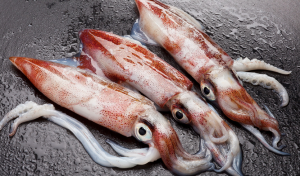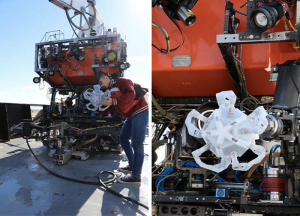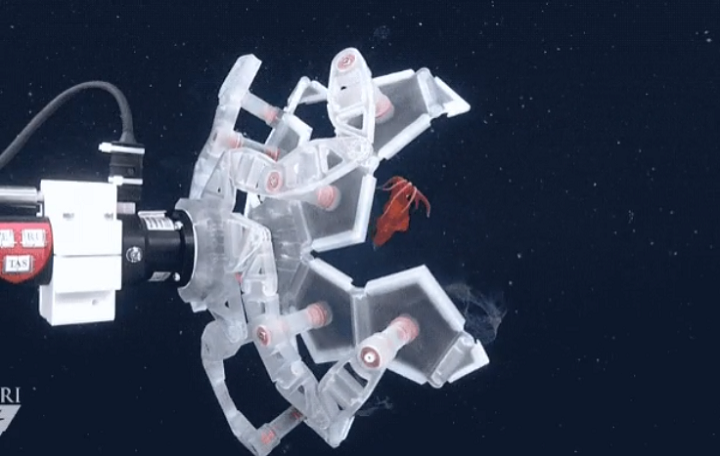 Many 3D printing applications and innovations, like self-folding objects, robots, and face masks, have been inspired by the Japanese paper folding art of origami. Now, a collaborative group of scientists from Harvard University, the University of Rhode Island, and City University of New York (CUNY) have combined the principles of 3D printing and origami to find a less damaging way to capture delicate, soft-bodied sea creatures like squids, anemones, and jellyfish.
Many 3D printing applications and innovations, like self-folding objects, robots, and face masks, have been inspired by the Japanese paper folding art of origami. Now, a collaborative group of scientists from Harvard University, the University of Rhode Island, and City University of New York (CUNY) have combined the principles of 3D printing and origami to find a less damaging way to capture delicate, soft-bodied sea creatures like squids, anemones, and jellyfish.
While soft forms like these are adapted to ocean pressures, it’s hard to catch them for the purposes of study without injuring the very subjects you want to learn more about. Marine biologist David Gruber, who helped design the capture device, says that these creatures are often called the “forgotten fauna” because their study has been so neglected. But the multi-university research team recently introduced its 3D printed, 12-sided trap, inspired by origami, that can fold around these animals gently, without harming them.
The RAD device, which is short for rotary actuated dodecahedron, is far better equipped for handling these delicate creatures than nets or suction samplers. It can be attached to the arm of an underwater rover, then triggered remotely, and has already successfully trapped jellyfish and small squid and octopuses at a depth of 700 meters. However, the design can work at depths up to 11 kilometres, with the possibility of being scaled up even further for larger creatures.

Still images showing the capture of three different types of soft-bodied sea life using the RAD. [Image: Wyss Institute at Harvard University]
The RAD has several other important design touches, including making the edges of the panels softer than the rest of the plastic device so creatures struggling to get out (which makes me sad to think about but I know it’s important to study these animals so I’ll just get over it) aren’t accidentally amputated. Additionally, there are gaps between each of the panels to pressure doesn’t build up inside when the RAD travels back up to the surface.
“I view this as a platform technology that we hope will continue to evolve. The dream is to enclose delicate deep-sea animals, take 3D imagery that includes properties like hardness, 3D-print that animal at the surface, and also have a ‘toothbrush’ tickle the organism to obtain its full genome. Then, we’d release it,” Gruber told the Verge.

L-R: Zhi Ern Teoh inspects the RAD when attached to an underwater rover; a closeup of the RAD folded shut. [Image: Kaitlyn Becker, Wyss Institute at Harvard]
3D printing has helped us sample the floor of the ocean and clean up debris from its shores, give coral reefs a helping hand, and quietly observe marine life. Now, this basic 3D printed origami mechanism can help us safely capture soft-bodied organisms for the purposes of study.
Gruber believes, and I tend to agree, that this kind of advanced technology is absolutely imperative to exploring our oceans without causing further harm to the myriad creatures that call them home. We are only just scratching the surface when it comes to figuring out just how important of a role marine life – from the tiniest sea cucumber to the most massive of coral reefs – can play in the overall ecosystem of the ocean.
The team published a paper on their development of the RAD in the Science Robotics journal, which you can read here. Co-authors are Teoh, Brennan T. Phillips, Kaitlyn P. Becker, Griffin Whittredge, James C. Weaver, Chuck Hoberman, Gruber, and Robert J. Wood.
Discuss this and other 3D printing topics at 3DPrintBoard.com or share your thoughts below.
Subscribe to Our Email Newsletter
Stay up-to-date on all the latest news from the 3D printing industry and receive information and offers from third party vendors.
Print Services
Upload your 3D Models and get them printed quickly and efficiently.
You May Also Like
Nikon SLM Solutions Sells SLM 500 to Primary Weapon Systems to Expand Suppressor Production
Primary Weapons Systems (PWS) is a Boise, Idaho-based manufacturer of suppressors, firearms, and related components. A subsidiary of Vigilant Gear and a sister company to aftermarket Glock slide manufacturer Lone...
3DPOD 261: Tooling and Cooling for AM with Jason Murphy, NXC MFG
Jason Murphy´s NXC MFG (Next Chapter Manufacturing) is not a generalist service; instead, the company specializes in making tooling. Using LPBF and binder jet, the company produces some of the...
HP and Firestorm Labs Form Partnership to Use Multi Jet Fusion 3D Printers in Deployable Factories
HP Inc., maker of a range of additive manufacturing (AM) solutions including the Multi Jet Fusion (MJF) ecosystem, has announced a partnership with Firestorm Labs, a developer of containerized, deployable...
3D Printing News Briefs, July 2, 2025: Copper Alloys, Defense Manufacturing, & More
We’re starting off with metals in today’s 3D Printing News Briefs, as Farsoon has unveiled a large-scale AM solution for copper alloys, and Meltio used its wire-laser metal solution to...

































